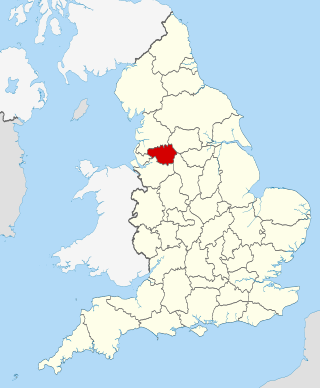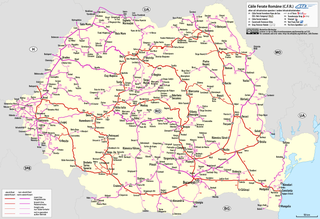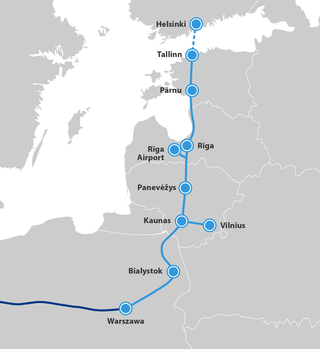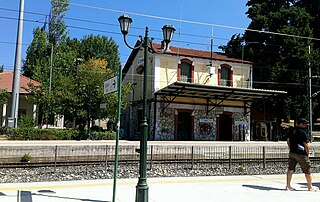
The railway system in Great Britain is the oldest railway system in the world. The first locomotive-hauled public railway opened in 1825, which was followed by an era of rapid expansion. Most of the track is managed by Network Rail, which in 2017 had a network of 9,824 miles (15,811 km) of standard-gauge lines, of which 3,339 miles (5,374 km) were electrified. In addition, some cities have separate metro, light rail and tram systems, among them the historic London Underground and the Glasgow Subway. There are also many private railways, some of them narrow-gauge, which are primarily short lines for tourists. The main rail network is connected with that of continental Europe by the Channel Tunnel and High Speed 1, opened in 1994 and 2007 respectively.

Transport in the United Kingdom is facilitated by road, rail, air and water networks. Some aspects of transport are a devolved matter, with each of the countries of the United Kingdom having separate systems under separate governments.

Transport in Norway is highly influenced by Norway's low population density, narrow shape and long coastline. Norway has old water transport traditions, but road, rail and air transport have increased in importance during the 20th century. Due to the low population density, public transport is somewhat less built out in rural areas of Norway, however public transport in and around cities is well developed.

SJ is a state-owned passenger train operator in Sweden. SJ was created in 2001, out of the public transport division of Statens Järnvägar, when the former government agency was divided into six separate state-owned limited companies. In 2018, SJ carried 31.8 million passengers.

The Norwegian railway system comprises 4,109 km of 1,435 mm track of which 2,644 km is electrified and 274 km double track. There are 697 tunnels and 2,760 bridges.

Vygruppen, branded as Vy, formerly the Norwegian State Railways, is a government-owned railway company which operates most passenger train services and many bus services in Norway. The company is owned by the Norwegian Ministry of Transport. Its sub-brands include Vy Buss coach services, CargoNet freight trains and the Swedish train transport company Tågkompaniet. In 2009, NSB carried 52 million train passengers and 104 million bus passengers. On 24 April 2019, passenger train and bus services were rebranded as Vy.

The Bergen Line, or the Bergen Railway, is a 371-kilometre (231 mi) long scenic standard gauge railway line between Bergen and Hønefoss, Norway. The name is often applied to the entire route from Bergen to Oslo, including the Randsfjord and Drammen lines between Hønefoss and Oslo, covering a total distance of 496 kilometres (308 mi). It is the highest mainline railway line in Northern Europe, crossing the Hardangervidda plateau at 1,237 metres (4,058 ft) above sea level.

Transport for Greater Manchester (TfGM) is a local government body responsible for co-ordinating transport services throughout Greater Manchester in North West England. It is an executive arm of the Greater Manchester Combined Authority (GMCA), the city region's administrative authority. The strategies and policies of Transport for Greater Manchester are set by the GMCA and its Greater Manchester Transport Committee (GMTC). The committee is made up of 33 councillors appointed from the ten Greater Manchester boroughs, as well as the Mayor of Greater Manchester.

Lithuanian Railways, is the national state-owned railway company of Lithuania. It operates most of the railway network in the country. It has several subsidiary companies, but the main ones are: LTG Link which provides passenger services, LTG Cargo which provides freight service, and LTG Infra which is responsible for the maintenance and development of the infrastructure.

The Polish State Railways is a Polish state-owned holding company comprising the rail transport holdings of the country's formerly dominant namesake railway operator. The company was reformed in 2001 when the former Polish State Railways state-owned enterprise was divided into several units based on the need for separation between infrastructure management and transport operations. Polish State Railways is the dominant company in the PKP Group collective that resulted from the split, and maintains 100% share control, being fully responsible for the assets of all of the other PKP Group component companies.

The Finnish railway network consists of a total track length of 9,216 km (5,727 mi). The railways are built with a broad 1,524 mm track gauge, of which 3,249 km (2,019 mi) is electrified. Passenger trains are operated by the state-owned enterprise VR that runs services on 7,225 km (4,489 mi) of track. These services cover all major cities and many rural areas, though the coverage is less than the coverage provided by the bus services. Most passenger train services originate or terminate at Helsinki Central railway station, and a large proportion of the passenger rail network radiates out of Helsinki. VR also operates freight services. Maintenance and construction of the railway network itself is the responsibility of the Finnish Rail Administration, which is a part of the Finnish Transport Agency. The network consists of six areal centres, that manage the use and maintenance of the routes in co-operation. Cargo yards and large stations may have their own signalling systems.

The first railway in the Kingdom of Romania opened in 1869 and linked Bucharest and Giurgiu. The first railway on electric current in the current Romanian territory opened in 1854, between Oravița and Baziaș in Banat, right next to the border with Serbia; however, that region was under the administration of the Austrian Empire at the time, and became part of Romania after World War I.

Russian Railways is a Russian fully state-owned vertically integrated railway company, both managing infrastructure and operating freight and passenger train services.
Jernbaneverket was a government agency responsible for owning, maintaining, operating and developing the Norwegian railway network, including the track, stations, classification yards, traffic management and timetables. Safety oversight was the duty of the Norwegian Railway Inspectorate, while numerous operating companies run trains on the lines; the largest being the state owned passenger company Vy and the freight company CargoNet.

Rail transport in Europe has diverse technological standards, operating concepts, and infrastructures. Common features are the widespread use of standard-gauge rail, high operational safety and a high share of electrification. Electrified railway networks operate at many different voltages, both AC and DC, varying from 750 to 25,000 volts, and signaling systems vary from country to country, complicating cross-border traffic.

Rail Baltica is an under-construction rail infrastructure project that is intended to integrate the Baltic states in the European rail network. Its purpose is to provide passenger and freight service between participating countries and improve rail connections between Central and Northern Europe, specifically the area southeast of the Baltic Sea. It is also intended as a catalyst for building the economic corridor in Northeastern Europe. The project envisages a continuous rail link from Tallinn (Estonia) to Warsaw (Poland), consisting of links via Riga (Latvia), Kaunas, and Vilnius (Lithuania). Its total length in the Baltic States is 870 kilometres (540 mi), with 213 kilometres (132 mi) in Estonia, 265 kilometres (165 mi) in Latvia, and 392 kilometres (244 mi) in Lithuania. Rail Baltica is one of the priority projects of the European Union (EU). It is part of the North Sea–Baltic Corridor of the Trans-European Transport Networks (TEN-T).

Agios Stefanos railway station is a station on the Piraeus–Platy railway line in the northern part of the Athens metropolitan area, in the municipal unit of Agios Stefanos of the municipality of Dionysos, East Attica, Greece. It was inaugurated on 8 March 1904 and reopened on 6 May 2005. It is owned by OSE, but service are provided by Hellenic Train, through the Athens Suburban Railway from Athens to Chalcis. The station was the setting for 1954 Greek film Neither Cat nor Damage, starring Vasilis Logothetidis.
Bane NOR SF is the Norwegian government agency responsible for owning, maintaining, operating and developing the Norwegian railway network, including the track, stations, and the majority of other infrastructure assets. It took over the operations of Jernbaneverket (railway administration) on 31 December 2016.
Great British Railways (GBR) is a planned state-owned railway company that is to oversee passenger rail transport in Great Britain, with the exception of Transport for London, Merseytravel, light rail and tram services.















